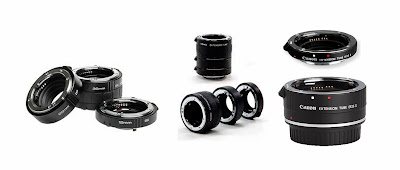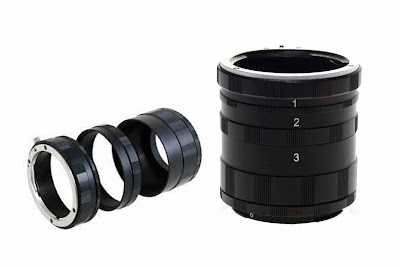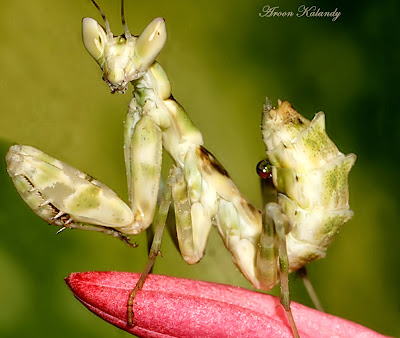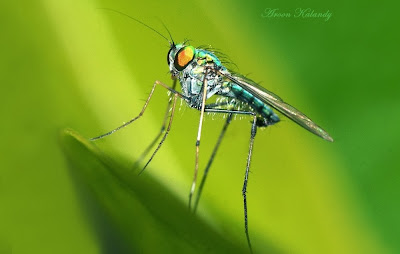There are many people who would like to give Macro photography a try to explore the micro world around them. But one single factor that stops most from taking the plunge is the high cost of equipment needed. Here in a series of articles we will discuss ways to bypass these costs and attain the high magnifications needed. In this article we will discuss about extension tubes, what are they, how they work, their advantages and disadvantages etc etc.
 |
| Extension Tubes |
What is an Extension Tube?
Extension tubes are spacers that you put between the camera and the lens so as to move the lens farther away from the sensor.
How Extension Tubes Work?
When distance from the lens to the sensor is increased it allows the lens to focus even closer on the subject than its normally possible, thereby increasing magnification.
Facts about Extension Tubes
Here are some basic facts about extension tubes which every photographer aspiring to do macro photography should know.
- Extension tubes are metal tubes which has a camera body mount at one end and a rear lens mount at the other.
- They are hollow tubes and do not have any lens elements in them.
- As extension tubes do not add any extra lens element to the equation it does not alter the quality of the image in any way. Image quality depends solely on the quality of the lens mounted on the tubes. So image quality should not be the criteria when choosing between different brands of extension tubes, instead you should choose one that has a better build quality especially if you intend to mount heavier lenses on it.
- When using extension tubes the lens will not focus to infinity. The focus range will be greatly limited to a very close focusing distance. So you are effectively gaining the ability to focus at very close distances by sacrificing the lens’s ability to focus at very far distances.
- Regardless of the type or make of extension tubes there is always a loss of light when extension tubes are used, the greater the length of the tube the greater the light loss, you will need to compensate for this when setting your exposure; but your TTL meter will be able to tell you the variables.
- If you plan on using relatively new macro or fast wide angle lenses which feature floating elements, it is recommended that you set the lens to close focus rather than setting it for infinity focus for better image quality.
There are two different kinds of extension tubes available in the market.
Auto Extension Tubes
 |
| Auto Extension Tubes |
There are extension tubes that have ability to maintain the electrical connections between the camera and the lens there by ensuring that aperture, exposure, autofocus etc all function as normal even with the extension tubes mounted between the camera and the lens. These are called Auto Extension Tubes. Major camera manufacturers like Canon, Nikon and Olympus make such extension tubes for their lenses but they tend to be very expensive, you could also get auto extension tubes from third party manufacturers like Kenko, Vivitar, Fotodiox etc. But even they are pricey when compared with extension tubes that are manual.
Manual Extension Tubes
 |
| Manual Extension Tubes |
These are just hollow pipes with camera mount on one end and a rear lens mount on the other. They do not allow any electrical contact between the camera and the lens. They are very cheap to own, if you are opting for manual extension tubes it is better to use a lens that has manual aperture ring so that you can easily adjust aperture. Setting exposure will not be an issue as the camera’s ttl meter will function as normal and all you need to do is set it to manual and adjust shutter speed and ISO to get exposure right. Focusing is also no big deal in macro as most professional macro photographers never use auto focus; it is much easier and much more precise when you do it manually. The live view feature combined with the ability to zoom the display up to 10x has really made this easier in this department.
Extension Tube Sizes
 |
| Extension Tube Sizes |
Extension tubes come in various sizes ranging from 8mm to 35mm. They are usually sold as sets of 3 tubes of three different lengths For example a 12 mm, 20 mm, and 36 mm, which can be used individually or in any combination to obtain the desired magnification. You can even stack multiple extension tube sets. The greater the extension is the greater the magnification.
Formula to Calculate Magnification achieved by different Extensions
An extension tube increases lens magnification by an amount equal to the extension distance divided by the lens focal length.
Here’s the formula for computing the magnification obtained using extension tubes of various lengths.
So from the equation it is evident that Extension tubes work best with lenses that are of short to medium focal lengths. They are less effective when used with telephoto lenses.
Pros and Cons of using Extension Tubes for Macro Photography
While extension tubes are certainly an effective method of getting high magnifications; they are definitely not the only way to do so. Weigh the following points carefully before deciding whether using extension tubes are the best solution for your macro needs or should you explore other ways to attain similar magnifications like using close up filters or even a dedicated macro lens.
Advantages of Using Extension Tubes for Macro Photography
- Extension tubes are inexpensive when compared to a dedicated macro lens.
- Different combinations of extension tubes allow you to get a wide range of magnifications with a single lens.
- Extension tubes do not have any glass elements and so they do not degrade the optical quality of your lens.
- The brand of extension tube is not important as they do not affect picture quality.
Disadvantages of Using Extension Tubes for Macro Photography
- They do not work well with lenses of longer focal length.
- Your lens loses the ability to focus on distant objects with extension tubes mounted between the camera and the lens.
- They significantly increase the effective f stop of your lens.
- Extension Tubes are rather awkward to use, to obtain different magnifications one should dis-assemble the set up add/remove tubes and then re-assemble everything. This along with focusing movement is how particular magnifications are obtained.
- Frequently taking of the lens and putting it back again raises the risk of dust settling on your camera sensor
- Not all lenses perform well when used with extension tubes some zoom lenses and macro lenses requires their rear element to be at a fixed distance from the sensor for optimum image quality.
- If you need feature like exposure, aperture, auto focus etc to work; you will need to buy auto extension tubes and they are expensive.
If you find the advantages outweigh the disadvantages do give it a try, if it’s the other way around will discuss some other alternatives to these extension tubes in future articles.
Here are some shots taken with extension tubes for your inspiration. The following images are all taken with a 90mm Tamron Macro lens along with a set of Kenko extension tubes.
 |
| extension tube macro photography tutorial |
 |
| extension tube macro photography |
 |
| extension tube macro tips |
 |
| extension tube macro |
 |
| how to use extension tubes |
 |
| macro photography using extension tubes |
 |
| using extension tubes for macro photography |
 |
| tips for using extension tubes |

Post a Comment